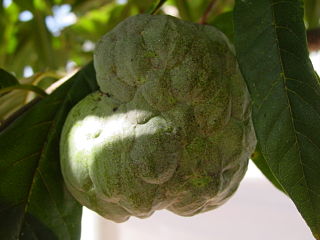
The Annonaceae are a family of flowering plants consisting of trees, shrubs, or rarely lianas commonly known as the custard apple family or soursop family. With 108 accepted genera and about 2400 known species, it is the largest family in the Magnoliales. Several genera produce edible fruit, most notably Annona, Anonidium, Asimina, Rollinia, and Uvaria. Its type genus is Annona. The family is concentrated in the tropics, with few species found in temperate regions. About 900 species are Neotropical, 450 are Afrotropical, and the remaining are Indomalayan.

Polyalthia is a genus of flowering plants in the family Annonaceae. There are approximately 90 species distributed from Africa to Asia and the Pacific.

Semecarpus australiensis, commonly known as the tar tree, native cashew, marking nut, or cedar plum, is a species of tree in the cashew and mango family Anacardiaceae, native to parts of Melanesia and northern Australia. Contact with the plant can cause serious allergic reactions, a common characteristic of this family.

Rhysotoechia is a genus of plants in the soapberry family Sapindaceae which is native to parts of Malesia and Australia.

Meiogyne cylindrocarpa, commonly known as fingersop or native apricot in Australia, is a small tree or shrub in the custard apple family Annonaceae, native to parts of tropical Asia and Australasia.

Huberantha cerasoides is a species of trees in the family Annonaceae and tribe Miliuseae. It is the type species of the relatively new genus Huberantha.
Herbert Franz Josef Huber was a German botanist. At the time of his death in 2005 he was professor emeritus at the University of Kaiserslautern, Germany. He is known for his contributions to the classification of angiosperms.

Huberantha is a genus of plants in the family Annonaceae and tribe Miliuseae. It is distributed in Australia, tropical Asia, East Africa and some Pacific islands. Tanawat Chaowasku named the genus "Huber's flowers" in honor of the German botanist Herbert Huber and to highlight its flowers as a distinguishing feature of the genus. A number of species have been moved here from the genus Polyalthia.
Wuodendron is a genus of plants in the family Annonaceae and tribe Miliuseae, containing the type and only species Wuodendron praecox. It is distributed from northeastern India north to southern China and southeast through most of Mainland Southeast Asia.

The Malmeoideae are a subfamily of trees and other plants of the family Annonaceae.
Polyalthiopsis is an Asian tree genus in the family Annonaceae and tribe Miliuseae. Its native range is southern Vietnam.

Pseuduvaria froggattii is a rare species of tree which is restricted to a very small part of northeastern Queensland, Australia. It is a member of the custard apple and soursop family Annonaceae, and was first described in 1887. Despite the small range its status considered to be least concern.

Diploglottis harpullioides, commonly known as Babinda tamarind, is a rainforest tree in the lychee and maple family Sapindaceae which is found only in northeast Queensland, Australia.

Meiogyne hirsuta is a plant in the custard apple family Annonaceae endemic to the Wet Tropics bioregion of Queensland, Australia. It is known from only a small number of collections from three widely separated locations.

Alpinia arctiflora, commonly known as the pleated ginger, is a plant in the ginger family Zingiberaceae which is endemic to northeastern Queensland.

Cleistanthus apodus, commonly known as the weeping Cleistanthus, is a tree in the family Phyllanthaceae native to New Guinea and northeast Queensland. It was first described in 1873 by the English botanist George Bentham in his seven-volume book Flora Australiensis.

Polyalthia fruticosa is a plant in the custard apple family Annonaceae found only in the northern half of Cape York Peninsula, Queensland, from the Torres Strait to the McIlwraith Range. It is a shrub up to 3 m (9.8 ft) tall, producing white flowers and red fruit. It was first described in 2007 as Haplostichanthus fruticosus by the Australian botanist Lawrence W. Jessup, and transferred to the genus Polyalthia in 2018 in a broad taxonomic review of the genus by Xue et al.

Monoon australe is a plant in the custard apple family Annonaceae found in the northern parts of the Australian states of Western Australia, the Northern Territory and Queensland. It was originally described as Popowia australis by the English botanist George Bentham in 1863, but it was transferred to its current combination in 2012 in a review of the closely related genus Polyalthia conducted by the botanist Bine Xue and others.

Monoon michaelii is a plant in the custard apple family Annonaceae found only in a very small part of the Wet Tropics bioregion of Queensland, Australia. It was originally described as Polyalthia michaelii in 1915 and transferred to its current name in 2012.

Xylopia maccreae, commonly known as orange jacket or MacCrea's xylopia, is a plant in the custard apple family Annonaceae found only in coastal areas of north and central Queensland, Australia. It is an evergreen tree up to 10 m (33 ft) tall with small buttresses, and young shoots covered in silky hairs. It was first described in 1868 as Melodorum maccreae by the botanist Ferdinand von Mueller, and transferred to the genus Xylopia in 1956 by Lindsay Stuart Smith. It is one of the food plants for the green-spotted triangle.





















